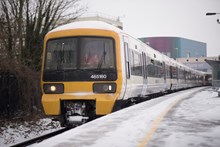"Unfortunately, this led to a serious incident in Lewisham which has taught us many lessons and inspired positive change, especially in how we've prepared for this winter.
"We're really sorry to passengers who were on board for what was an unpleasant and distressing experience. Together with our colleagues at Southeastern, we've taken action to minimise the chance of this happening again.
"We have improved the way we manage extreme weather, examined ways to keep the power on when the conductor rail fails and updated our procedures for communicating with passengers during emergencies."
As a result of the Lewisham incident, Network Rail and Southeastern are:
- Delivering new training to more than 3,500 staff, including scenario simulation of major incidents to ensure staff are well-rehearsed on emergency procedures.
- Network Rail is investigating expanding the installation of conductor rail heating to include key locations, like Lewisham, which although not prone to freezing could potentially benefit from heating in extreme weather events. A trial of a more effective anti-icer on our fleet of snow and ice treatment trains is being tested on the Sheerness line this winter. In addition, Southeastern is exploring the use of ice-breaker shoes on some passenger trains.
- We are eagerly awaiting the results of a trial on our neighbouring Wessex route, where they are testing the use of gapping leads. These are cables that can be physically attached to the third rail, so stranded trains can continue to receive power to run toilets, lights and PA systems, for example – all serious problems encountered in the Lewisham incident.
- We’ve now deployed airwave radios to our incident response teams to enhance our command and control arrangements when managing disruption
- Network Rail and Southeastern worked with specialist consultants on planning and preparation for severe weather. This included examining the criteria needed to decide if trains should be running in extreme weather, such as the snow and icy conditions experienced in March.
- We are also improving how they communicate during extreme winter weather. This includes investment in improved systems for providing information to customers; revised protocols for communication between teams on the ground and control centres; more effective procedures for liaising between different organisations involved in any future incident.
- Adjusted our extreme weather forecasting processes to better predict ice build-up on the conductor rail. Detailed forecasts from weather experts MetDesk help formulate local action plans during adverse weather to minimise disruption to passengers. The forecasts cover not just the weather but how the conditions will impact on specific railway infrastructure such as the tracks and conductor rails. A network of hundreds of monitoring stations also provides real-time weather data, enabling Network Rail to respond to conditions as they develop in real time.
- We have invested in 20 special backpacks, which can carry heated de-icer fluid. These will be supplied to mobile operations manager depots in key locations and be used when the shoe gear of stranded trains need to be de-iced quickly to ensure power returns to the train.

